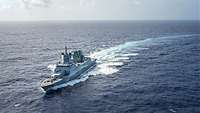
Indo-Pacific Deployment 2024
The German Navy’s major defence diplomacy project in the Indo-Pacific includes multinational naval exercises and operations.


The German Navy’s Indo-Pacific Deployment 2024 takes a German naval task group westward, first to the east coast of NATONorth Atlantic Treaty Organization partner Canada. The Royal Canadian Navy used their allies’ Atlantic crossing from May 7 to 17 for professional exchanges. With the German FGSFederal German Ship “Frankfurt am Main”, Canadian naval officers experienced a new class of replenishment ships that has not yet been commissioned into Canada’s naval forces.
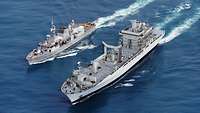
Long-range operations require efficient logistics, which is relevant for any globally operating navy including the Canadian. Rendering of a Protecteur-class Joint Support Ship with a Halifax-class frigate
Government of Canada/Gouvernement du Canada225 German sailors crossed the Atlantic with the replenishment ship “Frankfurt am Main”. Four Canadian guests were also on board. Commander Landon Creasy together with three other officers had joined the Germans for the ten-day trip from Wilhelmshaven on Germany’s North Sea coast to Halifax on Canada’s eastern seaboard. Creasy is the designated Commanding Officer of future Joint Support Ship HMCSHis/Her Majesty's Canadian Ship “Protecteur” of the Royal Canadian Navy.
The Canadian naval forces are currently having “Protecteur” and her sister ship “Preserver” built. The RCN expects Creasy’s new command to be delivered next year. The predecessor vessels of the new Protecteur class were not of the same type: not multi-purpose replenishment ships, but mainly fleet tankers. And they have been out of service for around ten years, with only a civilian interim solution to serve the RCN.
The Canadian navy therefore needs an update for the operation of replenishment vessels, such as those of the German Berlin class. This type of ship, which was built in Germany and which also includes the “Frankfurt am Main”, is also the model for the new Canadian naval vessel: the Protecteur class is a modified licensed build.
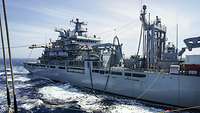
A standard procedure shared by all NATONorth Atlantic Treaty Organization partners: FGSFederal German Ship “Frankfurt am Main” during a replenishment-at-sea with another naval vessel
Bundeswehr/Nico TheskaAs with the German armed forces, the Canadian armed forces base their procurement of new systems on the capabilities they are supposed to offer. “What we looked at when planning for the Protecteur class wasn’t so much the ship itself, but it was what we wanted the ship to do,” explains Creasy.
The RCN had certain specifications regarding the size of its own shipyard and the size of the ship itself. The capabilities should provide an optimal mix of the greatest possible supply for combat ships as well as cross-service, i.e. joint, support. Aspects such as helicopter handling, the ship’s hospital and ammunition storage were also important to the Canadians.
The Berlin class from a German manufacturer would have been the best offer on the international market, the best mix of the capabilities required for the Canadian naval forces, says Creasy. “So, we purchased the design and made some changes to it.”
“For example, with the SH-148 Cyclone, we have a much larger multi-purpose helicopter than the German Navy,” says Lieutenant Commander Cyrus. He is the Cargo Management Officer of the future “Protecteur” and currently also oversees the position of Engineering Officer. “So, we had to adapt the shape and size of the hangar and make related design changes to the deck house,” he explains. “But, the hull form itself, the structure of the propulsion system or the fuel bunkers are fine as they are.”
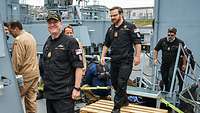
Commander Creasy (left) with his command team while the German ships are making fast in the port of Halifax
Bundeswehr/Nico TheskaThe Canadians’ main concern during their trip was the every-day operations on the German ship. “Every day on board was filled with getting to know the German way of working in detail, comparing it with ours – and above all with the way a replenishment ship works for us,” says Lieutenant Commander Ryan, Creasy’s Executive Officer. “It’s been about ten years since the Canadian navy has had this capability. And this vessel is much more alike to what we’re going to get than what our old replenishment ships were. That's ultimately why we're here: to pick your brain.”
Commander Creasy provides examples of this. “We are learning some practices from the German Navy that I really quite like, such as the management of the bridge team,” he adds to his Executive Officer. He and his officers also learned a lot about the military medical facilities and procedures on the German replenishment ship. “This will help us how we might staff ‘Protecteur’ to take full advantage of the medical capabilities that we’re putting on board the ship.”
After its commissioning, the first of the two Joint Support Ships of the RCN is planned to be assigned to Maritime Forces Pacific, its sister ship to Maritime Forces Atlantic. Such types of vessels are hugely important for the Canadian fleet, because it has to deal with enormous distances just in its home waters alone. Canada has the world’s longest coastline along three oceans: the Atlantic, the Pacific and the Arctic Ocean.
The RCN has two spatially separate large naval formations with bases on the east and west coasts – just like the German Navy, which is divided into formationas for two marginal seas: the North Sea and the Baltic Sea. But a trip from the Wilhelmshaven naval base to the Kiel base via the Kiel Canal only takes about a day. Canadian vessels need almost a month to move from Halifax, Nova Scotia through the Panama Canal to Esquimalt, British Columbia. Frigates, patrol vessels, coastal defence vessels and submarines of the Canadian navy can therefore make good use of capable replenishment ships.
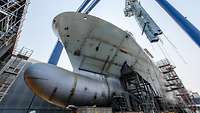
Canadian shipyard, German construction plans: the hull of future HMCSHis/Her Majesty's Canadian Ship “Protecteur” in Vancouver Shipyards, August 2023
Seaspan/21Stops.com/Mike SavageFor Landon Creasy, the trip on “Frankfurt am Main” was the first time he worked with the German Navy and thus also the first time he got to know the Berlin class. “So that was a grand adventure!" he says. He and his command team learned an astonishing amount about the ship in the ten days on board. Apart from details, the German and Canadian navies have more in common than they differ. “So we are very, very grateful for the opportunity not only to see the ship, but also to make new friends,” says Creasy.
As soon as HMCSHis/Her Majesty's Canadian Ship “Protecteur” is commissioned, the Canadians plan to invite their friends on the “Frankfurt am Main” for a return visit. This way they can present their new vessel and its changes in detail compared to the Berlin class. “My dream,” Creasy concludes, “would be to see HMCSHis/Her Majesty's Canadian Ship ‘Protecteur’ together with FGSFederal German Ship ‘Frankfurt am Main’ in a photo in the Pacific Ocean in a year and a half.”
by David Wähner, Marcus Mohr email